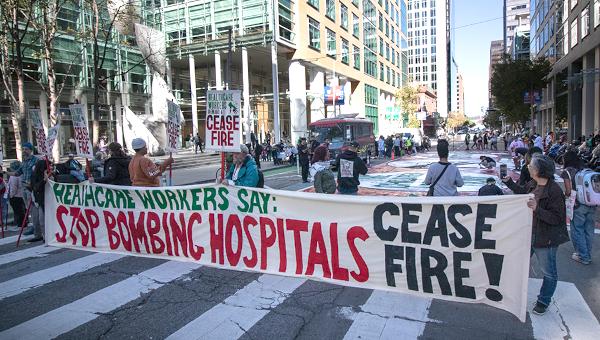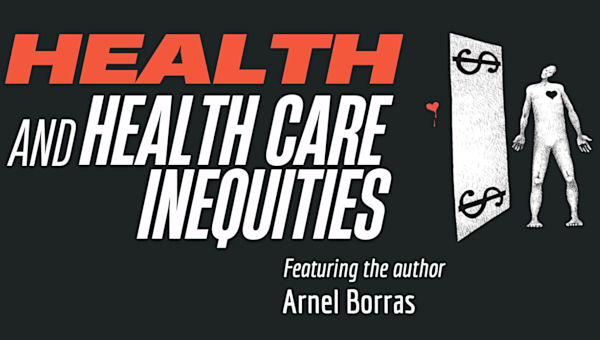Oaxaca En Lucha
Police forces have also launched an assault on the main university in Oaxaca. Over the last few days a battle has raged on Avenida Universidad. It is a north-south four-lane road a little over a half-mile long. University City occupies a roughly square block a little more than one-quarter mile on each side. This is the main campus of the Benito Juarez Autonomous University of Oaxaca, located about 1.1 mile southeast of the Zócalo, where the uprising has been centred. This area is supposedly ‘autonomous’ in the strict sense that the university authorities have exclusive control over the area. Police, military, federal authorities, and state officials are in principle not allowed to enter the grounds unless explicitly invited by the Rector of the university. The confrontations and uprising continue.
In support of the teachers and people of Oaxaca, and against the police actions and thuggery of the government, solidarity protests have been held in several cities across Canada, including a very successful demonstration today in Toronto at the Mexico Consul office in the heart of Bay Street, Canada’s financial district. The articles here discuss the Oaxaca uprising and the linkages between Mexico and the Canadian state.
Ulises Ya Cayo! Todo el Poder para el Pueblo!
Oaxaca, Mexico is currently the site of a radical popular uprising aimed at ousting the corrupt, repressive and illegitimate regime of Oaxacan Governor Ulises Ruiz Ortiz. This remarkable movement signifies a profound transformation in Oaxacan politics and political consciousness that could culminate in the emergence of real alternative political models in Oaxaca. Moreover, the Oaxacan struggle will undoubtedly serve as an example for other impoverished states dealing with dictatorial and corrupt governing bodies; particularly on the heals of fraudulent presidential elections that have deepened existing cleavages in the country.
The movement emerged in response to violent and repressive tactics that were utilized to suppress striking teachers affiliated with the National Education Workers Union – Section 22 (SNTE) on June 14, 2006. In Mexico, the SNTE 22 is known for its militancy and its commitment to social change. The teachers had been on strike since May 22, 2006. Their list of demands included legal recognition of Radio Plantón, an unlicensed community radio that serves as an important medium of communication for social activists and movements, improvements to educational infrastructure (construction of classrooms, laboratories and workshops; free student breakfasts; uniforms and more funding for scholarships and staff hiring) and salary increases. Ulises’ June 14 police raid was met with outrage and the 3,000 deployed police officers were driven out of the city centre by the teachers. The following day, thousands of people marched through the streets demanding that Governor Ruiz Ortiz step down. The number of deaths, disappeared, injured and detained is still unclear but it is believed that between six and nine people were killed and a woman miscarried. Moreover, installations of the Radio Plantón were destroyed and the SNTE 22 office building was vandalized.
The massive uprising now underway is a result not only of the abhorrent tactics employed on June 14 but in response to years of oppression, exploitation and injustice. Oaxaca is one of the three poorest states in the country and has the highest percentage of indigenous people of any state in Mexico. Its teachers are among the poorest paid. The state boasts sixteen different indigenous communities speaking a variety of dialects and maintaining distinct traditions and cultures. Over the last several decades, Mexican economic development policies have further entrenched Oaxacan communities in a cycle of bare subsistence and poverty. “Under pressure from the World Bank, the International Monetary Fund and conditions placed on U.S. bank loans and bailouts, the government has encouraged foreign investment, while cutting expenditures intended to raise rural incomes. Prices have risen dramatically since the government cut subsidies for necessities like gasoline, electricity, bus fares, tortillas, and milk.” In recent decades, Oaxaca has also seen a growth in foreign ownership of companies and businesses signifying the dismantling of unions and the further concentration of wealth and property in the hands of a few.
Furthermore, Oaxaca is home to ongoing electoral fraud, by which means Governor Ulises Ruiz Ortiz was elected. He represents the PRI (Partido Revolucionario Institucional), which maintained a dictatorship in Mexico for more than 70 years at the federal level. Although the presidency is now held by the PAN, the PRI maintains a stronghold in Oaxaca and continues its legacy of corruption, neoliberal economic policies and overt political repression. Political leaders silence Oaxacan protest and dissent through violent and repressive tactics, illegal arrests as well as politically motivated disappearances, torture and imprisonment.
The horrific events of June 14th coupled with decades of economic and political injustices provoked the Oaxacan people to respond to the state with demands for an alternative governing structure and the ousting of Governor Ulises Ruiz Ortiz. On June 17th, the People’s Popular Assembly of Oaxaca (APPO) was born as a mechanism through which to work towards these ends. The APPO is an association of diverse organizations and individuals including unions, student groups, NGOs, human rights groups and indigenous communities and groups dedicated to the ousting of Ruiz Ortiz, to community-based action, popular decision making and an alternative economic and political model. “[The APPO] is born in response to authoritarianism, to state terrorism, to fascism, it is born with the hope of a new world and future of equality, without the exploited and exploiters.”
The political actions of the APPO have escalated in numbers and scale. These actions include the occupation of state-owned radio stations and television stations, sit-ins, mega-marches of close to a million people and road blockades. Indeed, people from all over Mexico and abroad have been able to show solidarity with this movement through the utilization of the radio. Most recently, the APPO and its supporters marched from Oaxaca City to Mexico City. On October 9th, they arrived at the Zócalo in Mexico City where they set up an encampment outside the Senate buildings. The large group of marchers was met in many towns and communities with incredible support and solidarity. In Tepetlixpa Cuautla in the state of Morelos, the caravan was hit by a terrible rainstorm. The marchers set up camp but were soaked and cold. This town mobilized itself and organized sleeping arrangements for all of the marchers and provided them with clothes, food and food for the trip ahead. In Nezahualcoyotl, in the state of Mexico, the caravan received an incredibly warm reception. In Neza, the municipal president is Oaxacan as are many of the residents who sympathize with the unacceptable state violence and injustice characteristic of Oaxaca. Supporters such as those encountered by the protesters in Neza and Tepetlixpa Cuautla signify the ways in which other Mexicans now see political struggle as exemplified by Oaxaca as achievable.
However, as the movement becomes more and more powerful, state and business interests are taking measures to implement repressive and violent tactics in order to regain control of the state. Ruiz Ortiz has been accused on several occasions of an inability to govern Oaxaca as the state has been essentially paralyzed by the political actions of the APPO. Under pressure to resolve this crisis before Calderón, illegitimate winner of the 2006 presidential elections, assumes power in December, Ruiz Ortiz has resorted to clandestine tactics and a systematic violation of human rights in order to dismantle the movement. Since June, numerous disappearances have been reported as well as gunfire and brutal beatings at sit-ins and marches, harassment, destruction of property, illegal detention and torture of participants and the murder of many APPO organizers and supporters including children.
At the beginning of October, both marines and army troops were deployed to the city of Oaxaca and surrounding areas and repression seemed imminent. However, apart from ongoing repressive tactics carried out by plainclothes police and army personnel, a large-scale repression has not yet occurred. In response to accusations that Ruiz Ortiz has lost control of Oaxaca and at the request of the APPO and SNTE 22, the Senate, on October 13th, sent Senators to assess the crisis of Oaxaca and the level of unrest. A decision has not yet been made on this assessment as to whether or not Ulises Ruiz Ortiz will be requested to step down. This decision is expected as early as Tuesday, October 17, 2006.
At the same time, the Federal government has engaged in a dialogue with representatives of the SNTE 22 and APPO regarding an end to the strike and a return to work. The government offered a tantalizing economic package to the teachers, who in normal times receive poverty wages and are not suffering special hardship as a result of the suspension of their income since August. This package would provide back pay to all teachers who have been living without any income for several months. The offer expires as of October 16, 2006, at which time all teachers have been requested to return to work. If not, the Secretary of State Carlos Abascal Carranza has threatened that the use of public forces may be the only remaining option. Sub-secretary of Government, Arturo Chavez, has also stated that if an agreement cannot be reached, this will undoubtedly allow for consideration of “other kinds of actions.” Indeed, federal actors including Chavez and Carranza have confirmed that they feel confident about the steps they have taken in order to resolve the conflict peacefully and that they do not view the use of public forces as a failure of negotiations but rather as a part of politics.
As of October 9, 2006, Oaxacan state forces have been managed by the federal government in a so-called effort to ensure public safety and the re-establishment of security for Oaxacan people. However, on October 12, violence erupted once again in Oaxaca. Plainclothes police officers opened fire on a group of 120 teachers and members of the APPO in downtown Oaxaca. Four participants were injured. Ironically, the Sub-Commission of the Senate set to determine governability in Oaxaca was present in Oaxaca on the 12th. Moreover, on October 14th, military personnel dressed in plainclothes opened fire and killed Alejandro Garcia Hernandez at one of the barricades. Garcia Hernandez was shot twice in the head. Abascal and other government officials claim that such attacks are the work of “violent groups” but it appears rather likely that this explanation is merely an effort to assume impunity as is customary.
As a result of this political violence, teachers decided to cancel the State Assembly and consultations that had been scheduled to discuss the proposal of the Secretary of State until after the decision of the Senate or the removal of Ruiz Ortiz.
At the same time, the APPO continues to escalate its political action in response to repression and the unwillingness of Ruiz Ortiz to step down. The APPO has announced the commencement of a hunger strike that will continue until Ruiz Ortiz resigns. Members of the APPO and SNTE 22 have formed and re-enforced new security areas in Mexico City in key strategic locations including President Fox’s residency and federal government buildings. The APPO has also stated that they are planning a mega-march and a national protest based out of Mexico City slated for October 21st in solidarity with the Oaxacan struggle. Moreover, student groups, social groups and supporters of the SNTE and APPO are working tirelessly in Mexico City to disseminate information about the struggle and to coordinate solidarity actions on a national scale. In spite of violent state repression, the Oaxacan movement is transforming into a national struggle with international support and recognition.
As for the disappeared, imprisoned, tortured, murdered and injured members and supporters of the APPO and SNTE 22, there has been little mention of justice and even less recognition of the atrocities that have been committed by the Mexican state. The fight for recognition of these individuals and their sacrifices will be ongoing but it is certain that the Oaxacan people are committed to achieving justice through their struggle. Indeed, this process has already commenced. On October 13th, a group of Oaxacan lawyers presented evidence of state repression that occurred on June 14th to the Superior Tribunal of Justice. The outcome of this exhibition of evidence is not yet known but it signifies the ongoing strength and commitment of Oaxacans to the justice and dignity of those that have been harmed in the struggle for change.
Regardless of how things unfold in the coming weeks, the Oaxacan uprising has been an extraordinary success. In addition to state violence and repression, this movement has overcome and continues to work to overcome many challenges including a lack of resources, dissemination of misinformation at state and national levels by the Mexican government and bourgeoisie and the unification of diverse communities traditionally divided along lines of class, culture, ideology, language, education and geography. The Oaxacan struggle has created momentum for long-term political change in Oaxaca. Moreover, this movement has cultivated a new and strengthened social fabric that is unified in political consciousness and commitment to social change. Oaxaca will undoubtedly serve as an example of popular and democratic resistance in Mexico in spite of extreme efforts to dismember the movement by state force. •
Rogelio Cuevas Fuentes is a Oaxacan-born political activist currently living in Toronto. Lindsay Windhager is a graduate student at York studying
Mexican politics and themes of migration.
The Latin American Solidarity Committee of Toronto has been organizing a number of educationals and solidarity events and demonstrations around Latin America, including about the police riot in Atenco, the Presidential election fraud and the Oaxaca uprising. They have organized the following fact-sheets on linkages between Mexico and Canada with respect to the current events dramatically and quickly unfolding. Stay tuned for more events from LASC. They can be contacted through: groups.google.com/group/LASCToronto.
Prime Minister Harper and President-Elect Felipe Calderon:
In mid-July, Canadian Prime Minister Stephen Harper, a minority-government leader, along with NAFTA partner U.S. president George W. Bush, sent congratulations prematurely to right-wing PAN presidential candidate, Felipe Calderon – that is, before he was officially named president-elect in Mexico and amidst substantial charges of electoral fraud by leftist PRD candidate López Obrador. The Mexican Federal Electoral Institute has said that the elections were clean enough to count (while indeed recognizing many electoral irregularities).
Most recently, PM Harper and president-elect Felipe Calderon met in Ottawa on 26 October 2006 to discuss issues of security. Harper extended his support to Mexico against the U.S. building of a wall between Mexico and the USA, and Canada and the USA, saying that greater barriers would not create greater security. This high-level meeting followed a secret meeting in Banff, Alberta, Canada in mid-September 2006. Those in attendance included U.S. Secretary of Defense Donald Rumsfeld, Mexican Public Security Minister Eduardo Medina Mora, and Canadian Chief of Defense Staff Gen. Rick Hillier, as well as top executives from Lockheed Martin, Chevron, Petroleos Mexicanos, and Suncor Energy.
For Mexico’s part, on same day, and in the company of PM Harper, president-elect Calderon stated, “I plainly reject any intervention in the case of Oaxaca.” Calderon stated that the Federal government, and the outgoing President Fox, should not become involved in solving the problems of Oaxaca. At the same time, however, Calderon accused the teachers of committing a violation of human rights against the children of Oaxaca: “It’s a terrible violation to leave the children without classes, that the people suffer for a conflict of political interests.” Calderon furthered criticized the Teachers’ strike because it is damaging the economy of Oaxaca, an already very poor state.
The following day, 27 October 2006, Harper said of Calderon, “he’s a man of principles with a realistic political and economic vision of Mexico.”
Within 24 hours, the Teachers’ mobilizations were under attack by armed gunmen. The result was three people killed, eleven wounded, two disappeared, and one detained by the state police. Within two days, on 29 October 2006, outgoing President Fox ordered the Federal police to move on the teachers occupying the centre of Oaxaca.
That is, at the same time as Harper and Calderon exchanged self-congratulations on North American security and prosperity issues, Oaxacan teachers were being attacked by the Mexican government and being put in a situation of intense insecurity.
Canadian Capital Profits and Encourages Anti-Labour Policies in Mexico:
Canadian companies cannot be allowed to profit enormously under ongoing labour repression in Mexico.
As teachers were being attacked for demanding better working conditions and wages, Canadian banking giant Scotiabank in Mexico announced on 27 October 2006 its third quarter (alone) financial results for Mexico, with consolidated net profit of $111 million (CAD). This is while Scotiabank and other global banks in Mexico charge among the highest service fees in the world (40% or more than in Canada for the same service) and grant among the lowest level of loans to average workers!
The Bank of Nova Scotia is Canada’s third-largest bank. Scotiabank Inverlat as it is known in Mexico, has privileged position within Mexican state and power bloc as the country’s sixth-largest bank. Scotiabank expects to expand its credit portfolio by 20%, and hence profits. Scotiabank currently captures around 7% of bank credit in Mexico. The Mexican market is dominated by Spain’s BBVA and Santander, the USA Citigroup, HSBC of England, and one domestic owned Mexican-capital bank, Banorte.
Scotiabank has not had a progressive stance on labour in Mexico. For example, the day Grupo Mexico announced it was firing the Nacozari miners in July 2006, an anonymous Scotiabank spokesperson told Reuters that Mexican business welcomed the move, stating, “This sets a precedent, so the workers will think harder”.
The firing of the workers on 12 July 2006 was facilitated by the Mexican federal labour board, which was feeling emboldened by Calderon’s self-declaration as president elect and by international recognition of the right-wing candidate, which included PM Harper premature congratulations. On 12 July 2006 the board said the workers had abandoned their jobs, giving Grupo Mexico permission to close down mining operations altogether. The Nacozari mine is one of the world’s largest copper mines, where 1400 miners were on strike since 24 March 2006.
Neither has Scotiabank Inverlat been one of Mexico’s cleanest banks. In 2005, it was in fact fined for having been involved in money laundering activities in Mexico.
Scotiabank also plays an important and central role in Canadian-Mexican commercial relations. Scotiabank is a key sponsor of the Canadian Chamber of Commerce in Mexico. The current Vice-president Treasurer of the Canadian Chamber of Commerce is Pablo Aspe, who is the General Director of Retail and Enterprise for Scotiabank Inverlat in Mexico. In the past, Scotiabank has held the presidency as well.
Scotiabank has also assumed a much larger official role in Canadian-Mexican state-market relations. On 13 June 2006 Prime Minister Stephen Harper announced the Canadian membership for the newly formed North American Competitiveness Council (NACC). The NACC was launched at the Cancun meeting of North American leaders in March 2006. Rick Waugh, the head of Scotiabank Canada based in Toronto, has been named by PM Harper as one of the NACC members.
The NACC is composed of 30 senior private sector representatives, 10 from each country, and has a mandate to provide governments with recommendations on broad issues such as border facilitation and regulation, as well as on sectoral competitiveness (e.g., automotive, transportation, manufacturing and services). The NACC is set to meet annually with ministers charged with security and prosperity. The NACC will be also communicating with senior government officials on an ongoing basis. The NACC falls within the Security and Prosperity Partnership of North America initiative. Other Canadian members of the NACC include Dominic D’Alessandro (Manulife Financial); Paul Desmarais, Jr. (Power Corporation of Canada); David Ganong (Ganong Bros. Limited); Richard George (Suncor Energy Inc.); Hunter Harrison (CN); Linda Hasenfratz (Linamar Corporation); Michael Sabia (Bell Canada Enterprises); Jim Shepherd (Canfor Corporation); Annette Verschuren (The Home Depot).
As a representative of Canada, then, Waugh’s views are of some importance. At the same time as the Mexican government was cracking down on teachers in Oaxaca, Rick Waugh was presenting at York University’s Schulich School of Business. There, speaking on Mexico, Waugh stated that “globalization is not only a reality, it is no longer even a debatable point.” Waugh called on government, business and academic leaders to join forces to promote a foreign trade and investment policy that encourages domestic economic growth. Emphasizing how well Scotiabank has done in Mexico, he congratulated the Mexican government’s strong trade and foreign investment policies, which themselves have translated into strong domestic policy and created many jobs. “Clearly Scotiabank has done well through its investment – about $440 million in net income in 2005 – but so has Mexico and so has Canada,” said Waugh. “Our bank’s confidence in large part was based on a sound policy framework put in place by the governments of Mexico, Canada and the U.S. – specifically NAFTA – and Mexico’s strong support for open markets.”
Back in Mexico, the president of the Mexican Bankers’ Association, of which Scotiabank is a key member, stated in mid-October 2006, stated that banking programs will be put in place to help the business community of Oaxaca, which as suffered from the teachers’ strike. No support has been extended in favor of the striking teachers.
Canada Complicit in Mexican Government’s Anti-Democratic Anti-Laboour Policies:
On 28 September 2006, Mexican Ambassador María Teresa García de Madero awarded the Mexican Order of the Aguila Azteca to Ambassador Marc Lortie and Jean-Pierre Kingsley (as well as to Yves Ducharme). The Order of the Aguila Azteca, created in 1933, is the most important decoration granted by the Mexican Government to foreign citizens in recognition of their positive actions towards Mexico.
In presenting the awards, the Mexican Ambassador highlighted the Security and Prosperity Partnership of North America and NAFTA relations. First, Ambassador Lortie was congratulated for his role during the 2001 Quebec summit and for promoting democracy within the hemisphere. The Mexican Ambassador stated, “In Mexico, we are witnessing the results of a democratic reform opening up and transforming political institutions… They opened up their economy; they have changed the political way of doing things, and they are moving at a very impressive pace.”
Second, noting how Mexico is a country committed to democratic principles, Jean Pierre Kingsley, Canada’s Chief Electoral Officer was honored. She noted how Elections Canada has played a key role in consolidating Mexico’s democratic institutions by sharing its experiences with Mexico’s Federal Electoral Institute (IFE). She noted that in June 1996, IFE and Elections Canada signed an Agreement of Technical Cooperation, which was renewed in 2001 for another 5 years.
Jean Pierre Kingsley has invited the President of IFE, Luis Carlos Ugalde, to observe the Canadian electoral process in January of this year. President-elect Calderon is the godfather of Ugalde, who attested to the fraud-free electoral win of Calderon on 2 July 2006.
Prime Minister Stephen Harper’s office: pm@pm.gc.ca
The office of the Mexican ambassador to Canada: sdelvalle@embamexcan.com
The Mexican consulate in Toronto: cgmtoronto@consulmex.qc.ca
To learn more about the Oaxaca uprising:
- www.asambleapopulardeoaxaca.com
- www.oaxacaenlucha.blogspot.com
- www.noticias-oax.com.mx
- www.jornada.unam.mx
- mexico.indymedia.org/ImcMexico
- www.seccion22snte.org.mx
Denounce state repression and support the Oaxacan struggle by emailing and faxing the following people:
VICENTE FOX QUESADA PRESIDENTE CONSTITUCIONAL DE MÉXICO FAX. + 55 52 77 23 76, vicente.fox.quesada@presidencia.gob.mx LIC. CARLOS ABASCAL CARRANZA SECRETARIO DE GOBERNACIÓN FAX + 55 50 93 34 14, cabascal@segob.gov.mx DR. JOSÉ LUIS SOBERANES PRESIDENTE DE LA COMISIÓN NACIONAL DE DERECHOS HUMANOS FAX + 55 56 81 71 99, correo@cndh.gob.mx DANIEL CABEZA DE VACA PROCURADOR GENERAL DE LA REPÚBLICA FAX: +55 53460908, ofproc@pgr.gob.mx LIC. ULISES RUIZ ORTÍZ GOBERNADOR DEL ESTADO DE OAXACA Fax: + 951 5020530, gobernador@oaxaca.gob.mx





